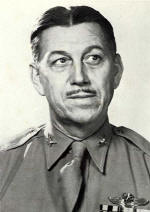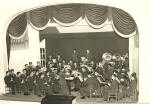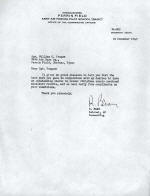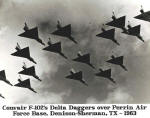|
Perrin and the
Community
“I thought of all the military bases I went to in
thirty-one years, this is the one that had the best relationship with
the community.” Ted Nurre (1956-)
[The base population was] altogether probably 3,000 to 4,000 people,
both military and civilian. The annual payroll was something like
twelve million dollars in Sherman and Denison.” Ken Hayes
(1953-1971)
|

Miss
Sherman and Miss Denison
Armed Forces Day, 1964 |
“I guess [Perrin] did make a lot of difference, because it brought in
a lot of people. I was just thinking about how downtown Sherman was so
alive at that time with all the drugstores and movies and department
stores and jewelry stories.” Wanda Moses
“I was assigned to drive, from time to time, [the commanding] officer
on the base. His name was Beam, Rosenham Beam. He was Jewish, I
think. He was a good man. He believed in you having a good time . . .”
Wilmire Jones (1942-1944)
 “[Colonel
Beam] was determined that we have a chorus. And he was determined that
we do The Messiah, which we all thought was outrageously ridiculous. We
recruited a whole bunch of people from Sherman and Denison and Perrin
Field, and one of the pilot instructors was a choral director. He was a
very small man, and he was the conductor. I remember the concert. I
will never forget it in my life. “[Colonel
Beam] was determined that we have a chorus. And he was determined that
we do The Messiah, which we all thought was outrageously ridiculous. We
recruited a whole bunch of people from Sherman and Denison and Perrin
Field, and one of the pilot instructors was a choral director. He was a
very small man, and he was the conductor. I remember the concert. I
will never forget it in my life.
 The conductor was standing in the pit. There were so many people there,
we couldn’t see [him]. At one point, we had five different tempos going
at once. It was total pandemonium. It was just awful. And the colonel
thought it was just marvelous.” Bill Teague (1942-1945) The conductor was standing in the pit. There were so many people there,
we couldn’t see [him]. At one point, we had five different tempos going
at once. It was total pandemonium. It was just awful. And the colonel
thought it was just marvelous.” Bill Teague (1942-1945)

 “There
was a period with little to no flying between 10:00 p.m. to 4:30 or 5:00
a.m., depending on when the weather mission got off, that you didn’t
hear any planes. But the rest of the time, there were always planes in
the air over Sherman and Denison, Pottsboro, and Lake Texoma. There were
always planes flying.” Ralph Waterloo (1963-1966) “There
was a period with little to no flying between 10:00 p.m. to 4:30 or 5:00
a.m., depending on when the weather mission got off, that you didn’t
hear any planes. But the rest of the time, there were always planes in
the air over Sherman and Denison, Pottsboro, and Lake Texoma. There were
always planes flying.” Ralph Waterloo (1963-1966)
Final Reflections
 |
